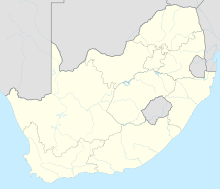Battle of Laing's Nek
| Battle of Laing's Nek | |||||||
|---|---|---|---|---|---|---|---|
| Part of First Boer War | |||||||
 Elizabeth Thompson's Floreat Etona! |
|||||||
|
|||||||
| Belligerents | |||||||
|
|
|
||||||
| Commanders and leaders | |||||||
|
|
|
||||||
| Strength | |||||||
| 1,216 | 2,000 | ||||||
| Casualties and losses | |||||||
| 84 dead 113 wounded 2 captured |
14 dead 27 wounded |
||||||
|
|
|||||||
The Battle of Laing's Nek was a major battle fought at Laing's Nek during the First Boer War on 28 January 1881.
Following the Boer declaration of independence for the Transvaal in 1880 the British suffered a series of disastrous defeats in attempting to regain the territory.
On 20 December 1880, Lieutenant-Colonel Philip Robert Anstruther and elements of his regiment, the 94th, marched from Lydenburg to Pretoria, the regiment’s band leading the column playing the popular song “Kiss Me, Mother Darling”.
At Bronkhorstspruit the force was stopped by Boers who courteously required the “Red Soldiers” to turn back. Anstruther equally courteously refused at which the column was devastated by rifle fire from the surrounding Boer ambush. Of the 259 in the column, 155 officers and men became casualties as did some of the women accompanying the regiment.
Instead of waiting for the reinforcements, the British High Commissioner for South East Africa, Major General Sir George Pomeroy Colley, assembled what troops he could and rushed forward, claiming to be moving to relieve the British garrisons in the Transvaal.
Colley gathered his force at Newcastle in Natal, dispatched an ultimatum to the Boers and, on its rejection, advanced towards the Transvaal border.
The first British camp on the march lay some 4 miles short of Laing’s Nek, a ridge in the foothills of the Drakensberg Mountains that blocked the road between Newcastle and Standerton in Natal, South Africa.
The British Natal Field Force, commanded by General Colley, numbered around 1,216 officers and men, including 5 companies of the 58th Regiment, 5 companies of the 3rd Battalion, the 60th Rifles, about 150 cavalry of the Mounted Squadron, a party of Royal Navy sailors and 4 guns of the Royal Artillery.
...
Wikipedia

